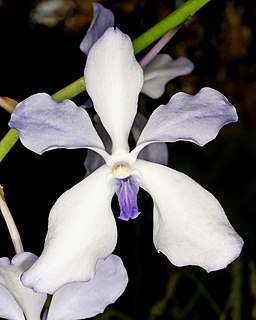
Vanda, abbreviated in the horticultural trade as V., is a genus in the orchid family, Orchidaceae. There are about 80 species, and the genus is commonly cultivated for the marketplace. This genus and its allies are considered to be among the most specifically adapted of all orchids within the Orchidaceae. The genus is highly prized in horticulture for its showy, fragrant, long-lasting, and intensely colorful flowers. Vanda species are widespread across East Asia, Southeast Asia, and New Guinea, with a few species extending into Queensland and some of the islands of the western Pacific.

Linaria is a genus of 150 species of flowering plants, one of several related groups commonly called toadflax. They are annuals and herbaceous perennials, and the largest genus in the Antirrhineae tribe of the plantain family Plantaginaceae.
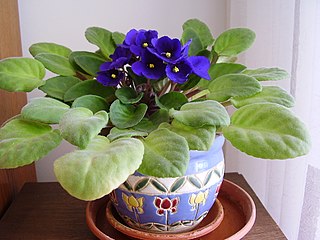
Gesneriaceae, the gesneriad family, is a family of flowering plants consisting of about 152 genera and ca. 3,540 species in the Old World and New World (Gesnerioideae) tropics and subtropics, with a very small number extending to temperate areas. Many species have colorful and showy flowers and are cultivated as ornamental plants.

Episcia is a genus of flowering plants in the African violet family, Gesneriaceae. The ten species it contains are native to the tropical regions of Central and South America. The species are perennial herbaceous plants characterized by a stoloniferous habit, red flowers, and frequently have marked or patterned leaves. Episcias are sometimes called flame violets.
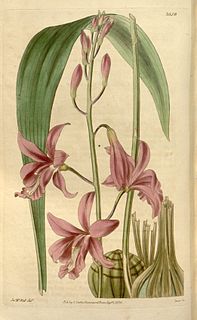
Bletia is a genus of about 30 species of orchids, almost all of which are terrestrial; some are occasionally lithophytic or epiphytic. It is named after Spanish botanist and pharmacist Don Luis Blet. The genus is widespread across Florida, Mexico, Central America, the West Indies, and South America as far south as Argentina.

Bignonia is a genus of flowering plants in the family Bignoniaceae. Its genus and family were named after Jean-Paul Bignon by his protégé Joseph Pitton de Tournefort in 1694, and the genus was established as part of modern botanical nomenclature in 1753 by Carl Linnaeus. Species have been recorded from the southern USA, Central to most of South America.

Alsobia is a genus of flowering plants in the family Gesneriaceae, native to Mexico, Guatemala, and Costa Rica. It contains two species.

Manettia is a genus of flowering plants in the family Rubiaceae. There are between 80 and 123 species. They are distributed in the West Indies, Mexico, and Central and South America. Most are vines. The genus was named after Saverio Manetti.
Asplundia lilacina is a species of plant in the Cyclanthaceae family. It is endemic to Ecuador. Its natural habitat is subtropical or tropical moist montane forests.
Manettia lilacina is a species of plant in the family Rubiaceae. It is endemic to Ecuador.
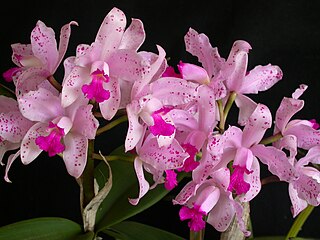
Cattleya amethystoglossa is a bifoliate species of orchid from the genus Cattleya.

Inocybe geophylla, commonly known as the earthy inocybe, common white inocybe or white fibercap, is a poisonous mushroom of the genus Inocybe. It is widespread and common in Europe and North America, appearing under both conifer and deciduous trees in summer and autumn. The fruiting body is a small all-white or cream mushroom with a fibrous silky umbonate cap and adnexed gills. An all-lilac variety lilacina is also common.

The lilacine amazon or Ecuadorian red-lored amazon is an amazon parrot native to Ecuador in South America. According to the IOC World Bird List, it is still considered to be a subspecies of the red-lored amazon, although Birdlife International considers it to be a separate species, as Amazona lilacina - as does the International Union for Conservation of Nature for the purposes of the IUCN Red List, rating the lilacine amazon as critically endangered.
Sarcoglyphis is a genus of flowering plants from the orchid family, Orchidaceae. It is native to Southeast Asia, the Himalayas and southern China.

Tayuva lilacina is a species of sea slug, a dorid nudibranch, shell-less marine gastropod mollusks in the family Discodorididae. A number of species descriptions are considered to be synonyms.
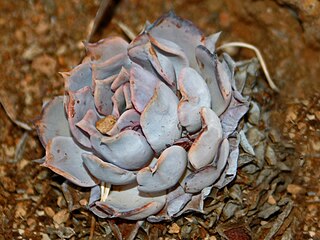
Echeveria lilacina, common name ghost echeveria or Mexican hens and chicks, is a species of succulent plants in the genus Echeveria belonging to the family Crassulaceae.

Paradrymonia lineata is a species of plant in the family Gesneriaceae.

Nautilocalyx bicolor is a species of plant in the family Gesneriaceae. It is endemic to South America.
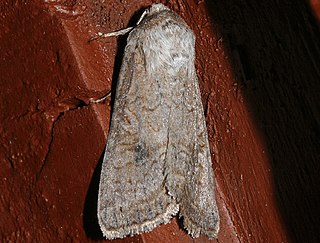
Trichordestra lilacina, the aster cutworm, is a species of cutworm or dart moth in the family Noctuidae. It is found in North America.

The Gesnerioideae are a subfamily of plants in the family Gesneriaceae: based on the type genus Gesneria. Although genera typically originate in the New World, some species have become widely distributed as ornamental plants.

















